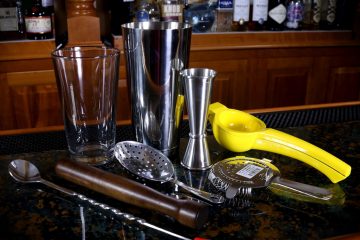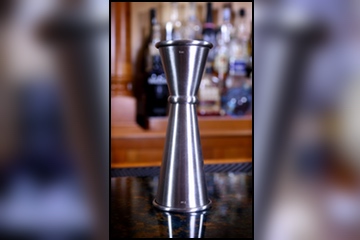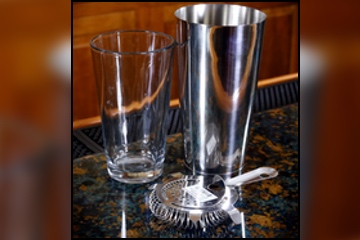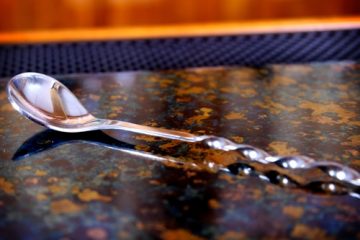Cocktail Dilution: A Song of Ice & Water
Cocktail dilution is key to a great craft cocktail. The traditional definition for a cocktail defined in 1806 by Harry Croswell was: “spirits, sugar, water and bitters.” The concept of ‘water’ has always existed in cocktails. An old fashioned cocktail contains a splash of water or club soda but not all cocktails call specifically for water. That same old fashion also calls for ice as well.
Using water in a cocktail is only one form of bringing water to your spirits. Cocktail dilution is usually obtained through the use of ice. As Dave Arnold (author of Liquid Intelligence) always says, “there is no chilling without dilution. There is no dilution without chilling.”
Cocktail dilution through water gives no chill to your cocktail. Ice, however, brings both dilution and chill. Most cocktails are enjoyed with a bit of chill which is why we welcome the use of ice.
Here are 10 chilling factors to consider when working with cocktail dilution:
#1 Cocktail Dilution Through Shaking
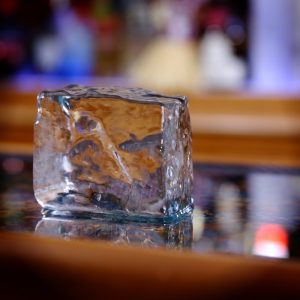
Clear Ice makes for slow melt in cocktails!
Shaking your cocktail is the fastest and most aggressive dilution method. You’ve got your home bartender starter kit so you’re shaker is in hand and you’re ready to bust out a cocktail! Most cocktails utilizing juice will call to be “shaken not stirred.” Unless you’re James Bond in a fictional reality, a spirit-only cocktail is stirred because it has no juice.
Shaking for 10 to 15 seconds will offer proper dilution for your cocktail. That balanced cocktail dilution brings out the rich aromas and flavors of the spirit while also cutting some of the aggressive nature of potent cocktails.
#2 Cocktail Dilution Through Stirring
Stirring a spirit-only cocktail is usually considered proper technique. Stirring brings both cocktail dilution as well as a clear final product and a silky texture. Aggressive shaking creates micro bubbles that change the flavor profile and mouth feel of a drink. That shake also diminishes much of the top notes and heart notes to your delicate spirits like gin, leaving more ‘base notes’ in its place.
Stirring a gin cocktail retains all the flavor notes and the full profile. Base notes in a gin tend to be rooty and bitter with an alcohol punch. However, balanced with those heart and top notes you incorporate your floral nuances associated with the spirit. Thus, shaking a gin martini gives you a more aggressive tasting experience that loses most of the work the distiller put into the spirit! While we are at it, here is a good resource for why you can’t bruise gin.
Stirring a cocktail isn’t as efficient as shaking. To gain the ultimate in proper dilution through stirring requires 2 minutes of stirring activity as compared to 15 seconds of shaking. You may not want to stir for 2 minutes but you should at least work it for 30 seconds.
#3 Cocktail Dilution Through Water
There are some classic cocktail designs that call specifically for club soda, sparkling water or flat water. These cocktail designs are typically room temperature and often rely on a chilled glass (and chilled water) to gain any temperature change. These classic designs can be challenging for new drinkers due to the overall lack of chill and spirit-forward flavor.
#4 Dilution to Cocktail Ratio
You want your dilution rate to be between 15% and 25% of your entire cocktail build. This process can be through shaking, stirring or directly adding water to your final product. Too little dilution will create a tighter (less flavorful) aroma and a stronger / stiff cocktail. Yet, too much dilution creates a weak “watered down” cocktail with less aroma and less flavor. The balance is key.
#5 Fresh ice vs. Shaken Ice
Unless specified by the cocktail recipe itself, always use fresh ice in your drink. Some cocktails call to “dump” or “pour shaker” into the glass. Most, however, will say “strain into” your glassware, which assumes you’ve got fresh ice in your drink ready to go!
Fresh ice melts slower because your drink has already reached a proper chilled temperature. Larger drinks often take longer to consume and the fresh ice allows the drink to stay cold longer without over-dilution. Of course, if the drink remains for too long additional dilution will become a factor. To solve this problem, make tasty drinks your imbiber wants to actually finish ahead of ice dilution becoming a factor.
#6 Don’t Let Ice Cubes Sweat Too Much
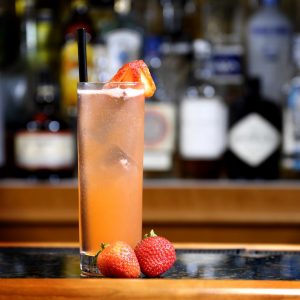
Strawberry Patch Cooler with Clear Ice for slow cocktail dilution!
Ice that sits in your ice bucket too long will gain a sheen of melt water on top of it. The ice loses some of its energy as it sits outside the freezer (as well as diminishes in size.) Using ice sooner than later offers a more efficient chill process.
However, when using larger ice cubes or clear ice blocks, allowing your ice to sweat a bit will avoid cracking when its added to your drink. Clear ice looks fantastic in a cocktail so let it gain the sheen of water before using it.
If your ice has a sheen of sweat on it, shake the ice with your ice tongs to get the water off the ice. That melt water will not chill down your drink as the energy was already lost in the melting process–it will simply over dilute your cocktail!
#7 Clear Ice Melts Slower — Great For Cocktails!
Clear and pure ice has less mineral content and less oxygen trapped in the ice (trapped oxygen contributes to the white ‘scarring’ cloud you find in your cubes). Oxygen and minerals cause ice to melt faster.
Using clear ice in your cocktails will lengthen its usefulness while not over diluting the final beverage if it sits for longer periods of time.
#8 Frozen / Chilled Spirits Impact Your Dilution Rate
Cocktail dilution loses its effectiveness when you keep your core spirits in the refrigerator or freezer. Dilution takes effect when room temperature ingredients create melt water on your ice. The melt water from the ice is the result of the transfer of energy into your ingredients.
Remember, there is no chilling without dilution. Keeping your spirits in the freezer is going to lower the dilution and overall taste experience of your cocktails. The only spirits kept at cold temperatures should be your cream based liqueurs. Irish Cream is often said to retain a crisp flavor when chilled and can increase your tasting experience.
Yet plenty of college kids keep their jagermeister in the freezer (even the Jagermeister company suggests doing this). However, this is often done because it softens the flavor of the spirit and makes it “easier to drink.” The chill on the tongue causes your taste receptors to diminish and numb thus creating a “smoother” flavor. But, this smoothness is really just an illusion of great taste because of the reduction of your senses do to extreme cold.
#9 Large Ice Cubes & Air Exposure
It’s fun to use large clear cubes of ice in your 2 oz of whiskey, right? You’ll see folks sporting large sphere ice cubes with a small amount of liquor and they’re feeling all high class and awesome. However, cocktail dilution loses its effectiveness if the ice is being exposed to the air. When your ice is rising out of your liquid it is chilling the air around the glass and that transfer of energy deposits melt water into your beverage. That melt water gave all its chill energy to the air, not the beverage!
Now, you have a beverage that’s over diluted and not as cold. Sad.
#10 High Surface Area Ice Melts Faster
Ice will melt faster if more more surface area is exposed–it’s science at work! Square ice has more surface area than round ice so it melts faster. Cracked ice has a higher surface area than cubed ice so it melts faster. Crushed ice has the highest surface area of all ice styles and thus it melts extremely fast.
I recommend you only used crushed ice in cocktail recipes that call for crushed ice. Cocktails with high alcohol content (e.g. many tiki cocktails) often call for crushed ice to balance out its intensity. What about those blended drinks? They often have a large degree of ice and a great blended cocktail often has a large degree of alcohol to counter balance it, be careful!
Choosing ice that fits your drink is important. Cocktails that have higher ABV usually require more chill (and thus higher surface area ice).
Conclusion – Get Some Trays
If you’re looking for ice with a slower melt time and good surface area, checkout the Perfect Cube Trays by Tovolo. These trays have a great cube size that works for both shaking and in your cocktail glassware. Want a bigger cube, Tovolo offers King Cube trays as well!










